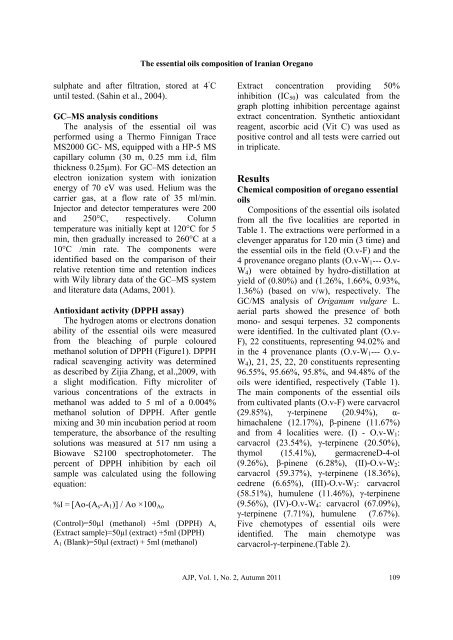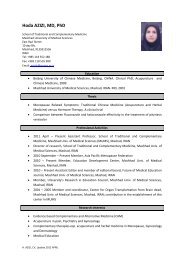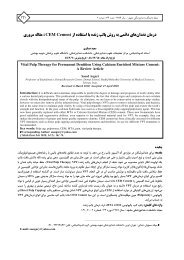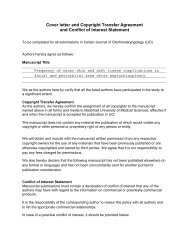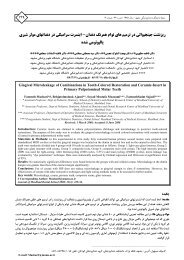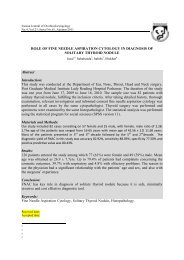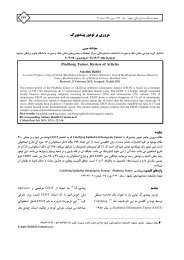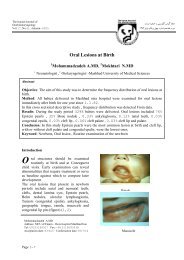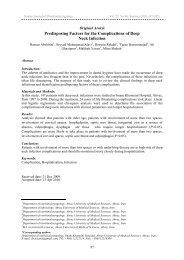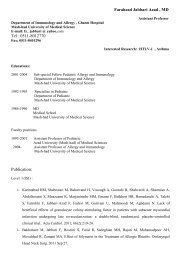The essential oils compositions of Iranian Oregano (Origanum ...
The essential oils compositions of Iranian Oregano (Origanum ...
The essential oils compositions of Iranian Oregano (Origanum ...
You also want an ePaper? Increase the reach of your titles
YUMPU automatically turns print PDFs into web optimized ePapers that Google loves.
<strong>The</strong> <strong>essential</strong> <strong>oils</strong> composition <strong>of</strong> <strong>Iranian</strong> <strong>Oregano</strong><br />
sulphate and after filtration, stored at 4 ◦ C<br />
until tested. (Sahin et al., 2004).<br />
GC–MS analysis conditions<br />
<strong>The</strong> analysis <strong>of</strong> the <strong>essential</strong> oil was<br />
performed using a <strong>The</strong>rmo Finnigan Trace<br />
MS2000 GC- MS, equipped with a HP-5 MS<br />
capillary column (30 m, 0.25 mm i.d, film<br />
thickness 0.25µm). For GC–MS detection an<br />
electron ionization system with ionization<br />
energy <strong>of</strong> 70 eV was used. Helium was the<br />
carrier gas, at a flow rate <strong>of</strong> 35 ml/min.<br />
Injector and detector temperatures were 200<br />
and 250°C, respectively. Column<br />
temperature was initially kept at 120°C for 5<br />
min, then gradually increased to 260°C at a<br />
10°C /min rate. <strong>The</strong> components were<br />
identified based on the comparison <strong>of</strong> their<br />
relative retention time and retention indices<br />
with Wily library data <strong>of</strong> the GC–MS system<br />
and literature data (Adams, 2001).<br />
Antioxidant activity (DPPH assay)<br />
<strong>The</strong> hydrogen atoms or electrons donation<br />
ability <strong>of</strong> the <strong>essential</strong> <strong>oils</strong> were measured<br />
from the bleaching <strong>of</strong> purple coloured<br />
methanol solution <strong>of</strong> DPPH (Figure1). DPPH<br />
radical scavenging activity was determined<br />
as described by Zijia Zhang, et al.,2009, with<br />
a slight modification. Fifty microliter <strong>of</strong><br />
various concentrations <strong>of</strong> the extracts in<br />
methanol was added to 5 ml <strong>of</strong> a 0.004%<br />
methanol solution <strong>of</strong> DPPH. After gentle<br />
mixing and 30 min incubation period at room<br />
temperature, the absorbance <strong>of</strong> the resulting<br />
solutions was measured at 517 nm using a<br />
Biowave S2100 spectrophotometer. <strong>The</strong><br />
percent <strong>of</strong> DPPH inhibition by each oil<br />
sample was calculated using the following<br />
equation:<br />
%I = [Ao-(A s -A 1 )] / Ao ×100 Ao<br />
(Control)=50µl (methanol) +5ml (DPPH) A s<br />
(Extract sample)=50µl (extract) +5ml (DPPH)<br />
A 1 (Blank)=50µl (extract) + 5ml (methanol)<br />
Extract concentration providing 50%<br />
inhibition (IC 50 ) was calculated from the<br />
graph plotting inhibition percentage against<br />
extract concentration. Synthetic antioxidant<br />
reagent, ascorbic acid (Vit C) was used as<br />
positive control and all tests were carried out<br />
in triplicate.<br />
Results<br />
Chemical composition <strong>of</strong> oregano <strong>essential</strong><br />
<strong>oils</strong><br />
Compositions <strong>of</strong> the <strong>essential</strong> <strong>oils</strong> isolated<br />
from all the five localities are reported in<br />
Table 1. <strong>The</strong> extractions were performed in a<br />
clevenger apparatus for 120 min (3 time) and<br />
the <strong>essential</strong> <strong>oils</strong> in the field (O.v-F) and the<br />
4 provenance oregano plants (O.v-W 1 --- O.v-<br />
W 4 ) were obtained by hydro-distillation at<br />
yield <strong>of</strong> (0.80%) and (1.26%, 1.66%, 0.93%,<br />
1.36%) (based on v/w), respectively. <strong>The</strong><br />
GC/MS analysis <strong>of</strong> <strong>Origanum</strong> vulgare L.<br />
aerial parts showed the presence <strong>of</strong> both<br />
mono- and sesqui terpenes. 32 components<br />
were identified. In the cultivated plant (O.v-<br />
F), 22 constituents, representing 94.02% and<br />
in the 4 provenance plants (O.v-W 1 --- O.v-<br />
W 4 ), 21, 25, 22, 20 constituents representing<br />
96.55%, 95.66%, 95.8%, and 94.48% <strong>of</strong> the<br />
<strong>oils</strong> were identified, respectively (Table 1).<br />
<strong>The</strong> main components <strong>of</strong> the <strong>essential</strong> <strong>oils</strong><br />
from cultivated plants (O.v-F) were carvacrol<br />
(29.85%), γ-terpinene (20.94%), α-<br />
himachalene (12.17%), β-pinene (11.67%)<br />
and from 4 localities were. (I) - O.v-W 1 :<br />
carvacrol (23.54%), γ-terpinene (20.50%),<br />
thymol (15.41%), germacreneD-4-ol<br />
(9.26%), β-pinene (6.28%), (II)-O.v-W 2 :<br />
carvacrol (59.37%), γ-terpinene (18.36%),<br />
cedrene (6.65%), (III)-O.v-W 3 : carvacrol<br />
(58.51%), humulene (11.46%), γ-terpinene<br />
(9.56%), (IV)-O.v-W 4 : carvacrol (67.09%),<br />
γ-terpinene (7.71%), humulene (7.67%).<br />
Five chemotypes <strong>of</strong> <strong>essential</strong> <strong>oils</strong> were<br />
identified. <strong>The</strong> main chemotype was<br />
carvacrol-γ-terpinene.(Table 2).<br />
AJP, Vol. 1, No. 2, Autumn 2011<br />
109


